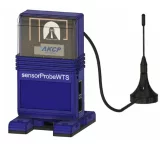An Ethernet gateway acts as a bridge between different types of networks, such as legacy serial-based systems (e.g., RS-232/RS-485) and modern Ethernet networks. It enables seamless communication by translating protocols and data formats, allowing devices with different communication standards to interact effectively.
Ethernet Gateways
Ethernet gateway devices or converters provide a way to connect devices to an Ethernet/IP network. The range of gateways available from Server Room Environments includes M-BUS gateways to collect data from meters using the M-BUS protocol, Modbus RTU to Modbus TCP/IP Ethernet converters, and Wireless Gateways which use LORA technology to provide an easy to deploy wireless monitoring system. Connecting to an IP network such as local area network or cloud-based monitoring portal allows data to be logged for historical analysis, viewed in realtime and used to trigger change of state or event notifications via email, SMS text, phone call or SNMP traps. Ethernet gateways can also provide a way to collect information for remote monitoring and reporting suing an Open API, XML, Modbus/TCP, MQTT or other Machine2Machine protocol.
-
Applications (40)
- Temperature & Humidity (30)
- Water Leakage Detection (26)
- Server Rack Monitoring (28)
- Hardwired Ethernet Devices (28)
- Wi-Fi Connectivity Units (8)
- Wireless Devices (13)
- Narrowband IoT Devices (4)
- GSM / LTE Comms (7)
- Battery Monitoring (7)
- Power Monitors (28)
- Security Monitors (26)
- Branch Circuits (2)
- Data Centres (7)
- Data Loggers (11)
- Data Aquisition Systems (11)
- Laboratories (18)
- Pharmaceutical (18)
- Accessories (158)
How Ethernet Gateways Work
An Ethernet gateway serves as a bridge between different types of networks, enabling devices that operate on various communication protocols to exchange data seamlessly. These gateways are critical in networking and industrial applications where devices using Ethernet, a wired local area network (LAN) protocol, need to interact with systems using other protocols, such as Wi-Fi, Zigbee, Modbus, or even legacy systems.
The Basics of Ethernet
Ethernet is a widely adopted networking standard that connects devices within a LAN using a set of protocols defined by the IEEE 802.3 standard. Ethernet allows devices to communicate over a physical medium (typically copper or fiber optic cables) using data packets. Devices on an Ethernet network must follow a standardized communication format to send and receive these packets.
The Role of an Ethernet Gateway
An Ethernet gateway facilitates communication between devices that operate on different networks or protocols. It acts as a translator, converting data packets from one protocol into another. This translation allows seamless communication between incompatible systems, such as Ethernet-enabled devices and those that use fieldbus, serial communication, or wireless protocols.
Components of an Ethernet Gateway
An Ethernet gateway typically includes several key components:
- Network Interfaces: These include physical Ethernet ports and, in some cases, interfaces for other protocols like RS-232, RS-485, or wireless modules.
- Protocol Converter: The gateway houses firmware or software capable of understanding and translating between different protocols.
- Processor and Memory: A processor handles the data conversion and routing, while memory stores configuration settings and temporary data.
- Power Supply: This provides the necessary electrical energy to the gateway, often through an external power source or Power over Ethernet (PoE).
- Management Interface: Many gateways offer web interfaces or dedicated software for configuration and monitoring.
How Data Flows Through an Ethernet Gateway
- Input Reception: The gateway receives data packets from a device on one network. For instance, it might receive Modbus RTU commands over a serial interface.
- Protocol Translation: The gateway parses the incoming data, interprets the protocol-specific information, and converts it into the target protocol format. For example, a Modbus RTU command could be converted into a Modbus TCP packet suitable for Ethernet networks.
- Output Transmission: Once translated, the gateway sends the data to the intended recipient over the target network.
- Response Handling: If the communication involves a query-response interaction, the gateway also receives responses from the target device, translates them back to the source protocol, and forwards them to the original sender.
Applications of Ethernet Gateways
Ethernet gateways are widely used across various sectors:
- Industrial Automation:They connect legacy industrial equipment using serial communication protocols to modern Ethernet-based systems, enabling integration with Supervisory Control and Data Acquisition (SCADA) systems.
- Smart Homes: Gateways allow communication between Ethernet-based home automation controllers and devices using Zigbee, Z-Wave, or Wi-Fi.
- IoT (Internet of Things): Gateways link IoT devices using diverse communication standards to cloud-based services via Ethernet.
- Enterprise Networking: Gateways connect isolated networks within large organizations, facilitating data exchange and ensuring compatibility.
Security Considerations
Since Ethernet gateways often handle sensitive data, they need robust security features such as encryption, authentication, and firewall capabilities to prevent unauthorized access and protect against cyberattacks.
Ethernet gateways are indispensable for connecting disparate systems in modern networking environments. By bridging the communication gap between different protocols, they enable the smooth operation of complex systems in industries, homes, and enterprises. Their versatility and efficiency make them a cornerstone of modern connectivity.
For more information on our Remote Monitoring Gateways please contact our Projects Team.

Earn SRE points on all online purchases with double points on selected products





































